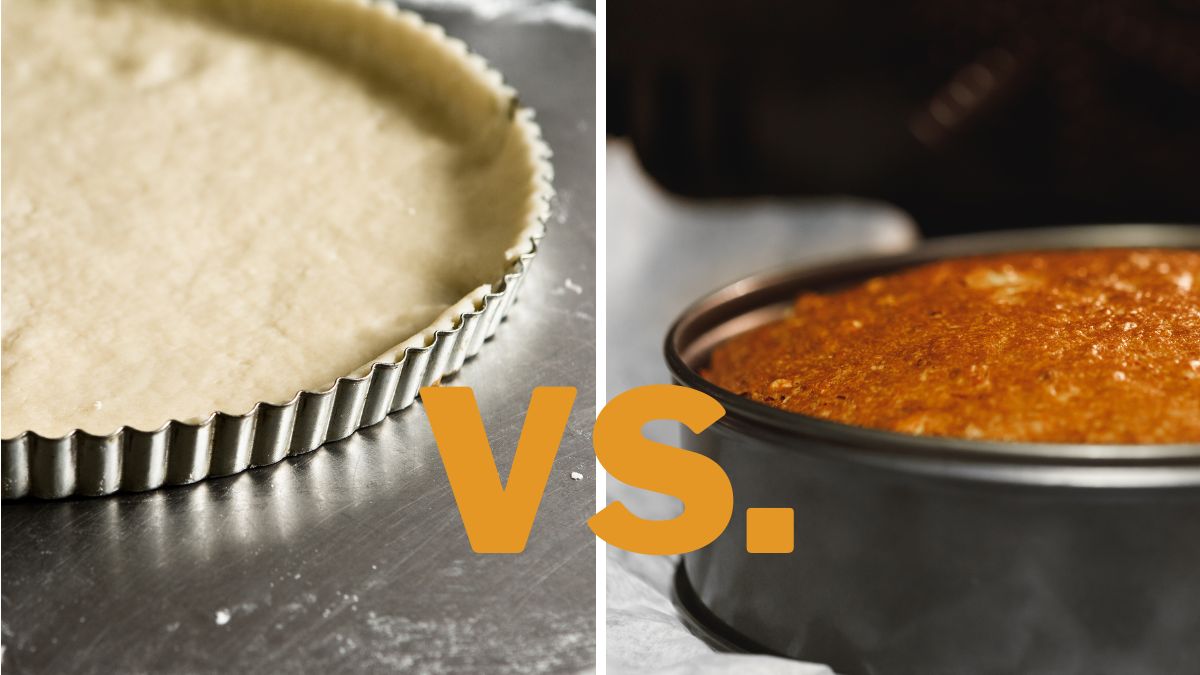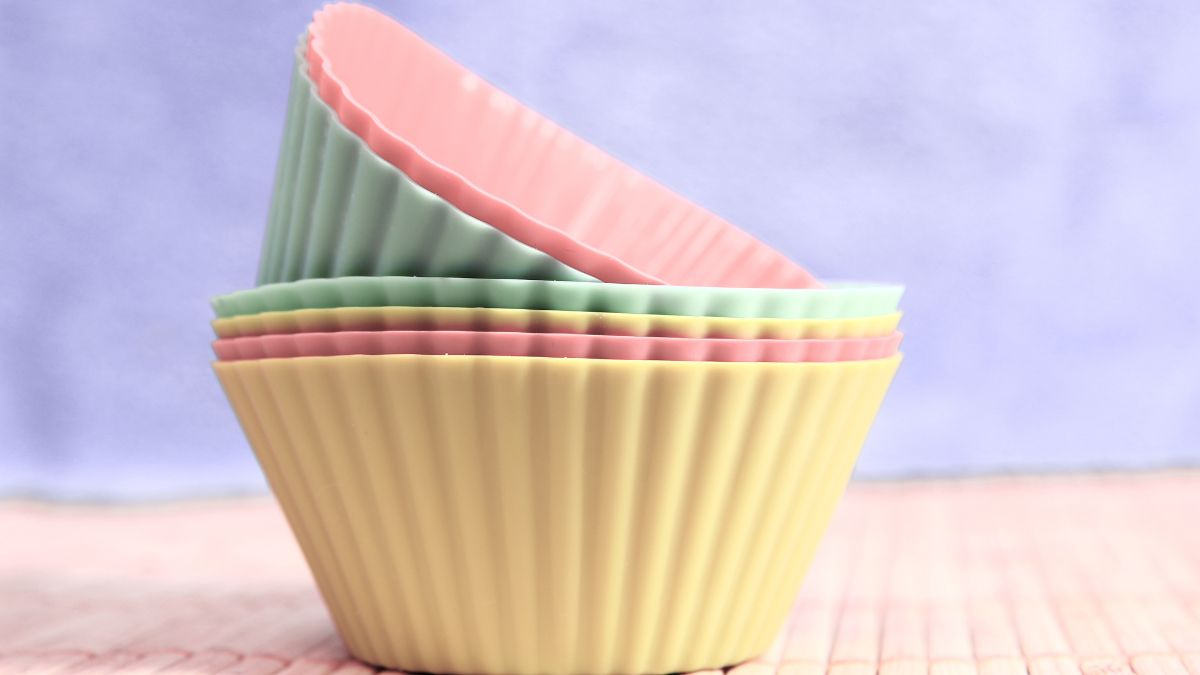Pie Pans vs. Cake Pans: Differences & Uses

I’m sure you use both pie pans and cake pans in your kitchen, just like me. How could we not? They are necessary kitchen tools for baking desserts, and there’s no grey area here; if you want to bake desserts, you have to have them. Each pan’s design, size, material, and usage differ significantly so that you can make the most out of each and every one. But, what are the differences between pie pans and cake pans?
Pie pans are shallower with angled sides to allow for easy release of pies and their fillings. Cake pans are deeper with straight sides, allowing the cake to rise and retain its shape. Cake pans also often have a removable bottom for easier cake removal.
If you want to bake desserts the right way, knowing the differences between pie pans and cake pans is essential. Therefore, in the following paragraphs, I will tell you all you need to know about these two types of pans.
Appearance
Both pie and cake pans come in different shapes, but round is how you will mostly find them.
Pie pans are usually round, but they can also come in rectangular or oval shapes. They can vary in size from very small at 4 inches to quite large at 12 inches in diameter. The typical size for a pie pan is 9 inches across and 1-2 inches deep. The angled sides of the pan help the crust form properly.
Cake pans are designed to make layer cakes with smooth edges. Therefore, they have straight sides and a flat bottom and are usually round or square-shaped. They come in a range of sizes, but the most common is a 9-inch round pan that is 2 inches deep.
Uses

Each type of pan obviously has different uses, which is pretty much self-explanatory from their names. In a nutshell, pie pans are used to make pies, and cake pans are used to make cakes.
However, pie pans can be used to make tarts and quiches because their design has been made so that they can be used to bake pastry shells. The fragile nature of pie crust or any other pastry shell requires a gentle touch when handling, and the angled sides of a pie pan make it easier to remove the pie without damaging the crust.
The flat bottom of a pie pan ensures that the crust is evenly baked. Pie pans are often made of glass, ceramic, or metal, and they can be used for both savory and sweet pies.
Cake pans, on the other hand, are used to make cakes. Cakes are typically denser and spongier than pies, and they need a deeper pan so that the batter can rise. Such pans come in various shapes and sizes, and you can use them to make different cake designs.
Springform cake pans are ideal for cheesecakes, as removing them from a regular cake pan can be a bit of a struggle. Cake pans can be made from metal, glass, silicone, or ceramic.
Material
The material of each pan significantly impacts its performance and, with it, its use. Glass pans are popular because they allow you to see the crust or cake while it bakes, making it easier for you to track your baked goods. Glass pans also don’t interact with acidic ingredients, like lemon juice or vinegar, meaning that the flavor of what you are baking won’t change due to a chemical reaction.
However, the glass pan is a very fragile one. Even though they have been designed to withstand heat and impact, they can crack or shatter if dropped.
Metal pans can be aluminum or steel pans, and they are the most common type. Metal pans are strong and easy to handle, distributing the heat excellently and evenly. However, metal pans are known to react with acidic ingredients, which can cause your baked good to have a slightly metallic taste.
To avoid this, I usually layer the pan with baking paper before popping it in the oven. Trust me, it will make your life easier.
Silicone pans are also an option, but not one I would recommend. On the plus side, they are flexible and easy to handle; however, the silicon does not allow for a nice crust, evenly baked batter, or filling. Still, I like to use silicon molds for smaller desserts, such as cupcakes, for example.

Ceramic pans are very elegant-looking and can go from oven to table, and they are excellent for serving. They are heavy and retain heat well, but they can be prone to cracking or chipping if dropped.
Can You Bake a Pie in Cake Pan?
While it is technically possible to bake a pie in a cake pan, you should consider several factors before attempting to do so. Pie and cake pans are designed with different purposes for a reason, and this little experiment can affect the outcome of your baked goods.
One of the main differences is their depth. Pie pans are typically shallower than cake pans, which can affect the way the crust and filling cook. If you use a cake pan for a pie, you may need to adjust the recipe to ensure the filling does not overflow or undercook.
Another thing to think about is the material of the pan. Most cake pans are made from lightweight aluminum or non-stick materials, while pie pans are often made from heavier materials such as ceramic or glass. This can affect how the heat is distributed throughout the pan and may impact the texture and consistency of your baked goods.
If you decide to bake a pie in a cake pan, choosing the right size pan is important as adjusting the recipe as needed. Definitely consider using a cover or foil so the edges don’t burn.
Can You Use Pie Pan for a Cake?
Generally speaking, yes, you can use a pie pan for baking cakes, though there may be better decisions. Since pie pans are usually shallow and have tilted sides, it can be challenging to bake a layer cake or a cake of a certain height. A cake batter usually rises, which can make it spill out of the pan.
It’s vital to consider and adjust the recipe and its particular requirements before using a pie pan for a cake. For example, a dense cake may work well in a pie pan because it won’t rise as much, while a lighter cake would require a deeper pan to help it rise and hold its shape.
If you do choose to use a pie pan for a cake, make sure to adjust the baking time and temperature accordingly.
